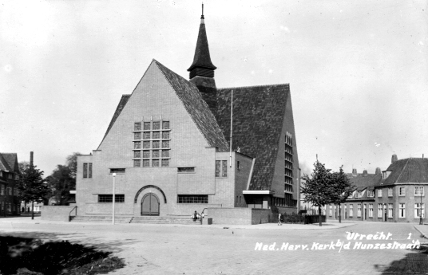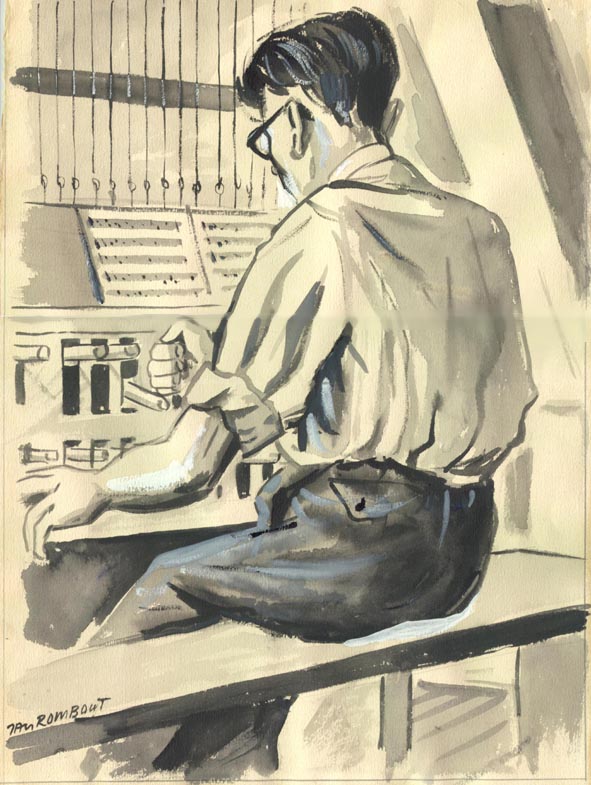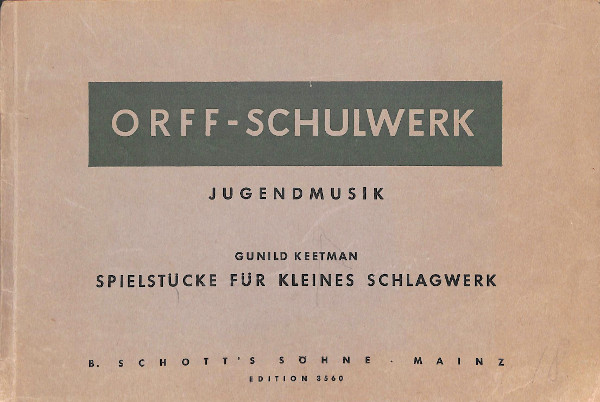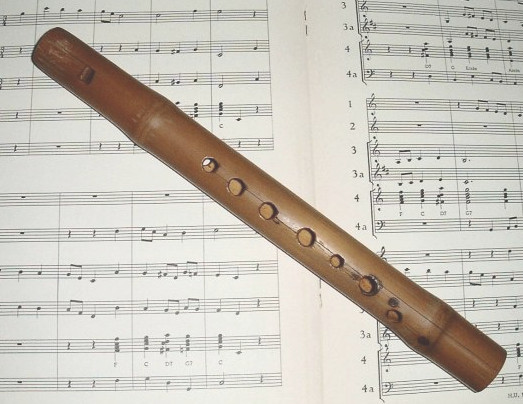Stichting De Traditie -
Cultural
Heritage



Nijmegen - Music
Around the St. Stephanus Church





Arie Peters’ first action as organist of the St Stephanus Church at Nijmegen was on 21 October 1936. He then succeeded his renowned predecessor Willem de Vries with a memorial service at the occasion of the 160 years existence of the König organ (Het Vaderland, 22 October 1936). Arie's actual career as organist began in January 1932 with a performance on the Witte-organ* in the then just finished Juliana Church at Utrecht. When he moved from Utrecht to Nijmegen, Stoffel van Viegen became his temporary successor at the Utrecht church (Wikipedia). Unlike Willem de Vries, Arie Peters could not rely on a family of organists. His father gained an income as dock-hand (sjouwerman). The preludium of his career as an organist was training in typewriting (1922), stenography (1923), and bookkeeping (1926), followed by a job at the Utrecht Bread- and Flour-Mill (1927). In 1927 he gained the Diploma A of the Netherlands Organists Society. He also had organ lessons from his great example Hendrik Franciscus Bos, organist of the Utrecht Dom Church.
1931 Is the year when the Juliana Church was used for the first time, and when Arie's a capella choir gave a performance in the building of ' Kunsten en Wetenschappen' at Utrecht. One year later the first annual convention of this choir takes place, with singing of Ali Witzel, soprano. In 1933 Arie gains the Diploma A of the Netherlands Organists Society for Church and Concert Play, and the Diploma B in 1938. In 1939 Arie gains a degree as choir director of the ' Koninklijke Bond Christelijke Zang- en Oratorium Vereeniging', and in 1941 he passes the ' Staatsexamen Muziek', the diploma of practical music instruction. Then 22 February 1944 arrives. The city center of Nijmegen is bombed by the allies. More than 800 civilians are killed, and the city center is destroyed. Gone also are carillon and organ. The sudden absence of musical instruments causes diversification. Arie searches for alternative organs to play. The organ of the 'Centraal Gebouw' of the Netherlands Reformed Community (corner Bijleveldsingel-Hoogersstraat) becomes his instrument, followed in 1950 by the organ of the 'Opstandings Church' (corner Kwakkenbergweg-Broerdijk). The diminished income is more or less complemented by reviews for the Nijmeegs Dagblad (journal), judging band contests, a choirmastership, guest performances on carrillons that have remained intact, musical accompaniment of recitations of the Beatrijs, and organ accompaniment of memorial and wedding services. In 1969, 25 years after the destruction of the St Stephanus Church, the reconstruction of the church is finished, and the characteristic features of the König organ can be enjoyed again. The formal opening of the church took place on 19 September 1969 with the first service after the reconstruction.
*The Witte-organ was built in 1874 to be placed in the 'Geertekerk' at Utrecht. When the Juliana Church was opened, the Geertekerk was taken out of service, and its organ was moved. After closure and demolition of the Juliana Church (1983), the organ was moved to the Reformed Church at Geervliet-NL.
Images from top to bottom:





On the first of November 1935, the City Council nominates Arie as carillonneur of the city of Nijmegen. The very art of having the bells sing was problably mastered only after his appointment by intensive training on the dummy keyboard made by his father in law. His father in law, Carel Alexander Walhof - a gifted and careful joiner - constructed a dummy keyboard for him that, judging from the pictures of that time, was an exact copy of the real console in Nijmegen. A dummy keyboard without bells, unfortunately. In Arie's study we see a piano, a harmonium, and a dummy carillon keyboard, apart from a desk and bookcases. Carillon lessons were given by Jan Wagenaar from Utrecht. However, since 1938 he also took lessons from Staf Nees, teacher at the famous carillon school at Mechelen, Belgium. Staf Nees taught him how to have the bells sing from the tower. At the beginning of his career, he followed the example of Willem de Vries, by writing down the melody put on the drum of the automatic mechanism by his predecessor (see left). It must have been rather an investment to travel from Nijmegen to Mechelen for weekly lessons in a car-less era; apparently Arie knew the value and qualities of his teacher. Printed carillon music is rather scarce. As a consequence, many already existing pieces of music had to be adapted to the different carillons with their different bell ranges. The collection of music leaflets transposed and adapted by Arie, offer a challenging task. So far 3102 pages were digitized by Stichting De Traditie. The destruction of the church and organ, was accompanied by the destruction of the tower and carillon. Nijmegen was finished. To avoid any misunderstanding about the situation, the city council of Nijmegen, dismissed Arie from his task - with honour - per 1 October 1945, due to the destruction of the tower of the St. Stephanus Church. The reconstruction after the war lasted long. Arie decided to apply for positions at the city of Haarlem. He missed the position of organist, but he was appointed as carillonneur of the St. Bavo in January 1953. Not much later, the reconstruction of the St Stephanus tower happened to be finished, so that his re-appointment as Nijmegen carillonneur followed in July 1953. The Netherlands were recovering, as appears from a formal job description, where he has to his surprise to count the number of steps he has to climb in order to reach his carillon; and at what temperatures...... His career as carillonneur is enriched by a job in Cuijck near Nijmegen. He plays the carillons of Nijmegen and Haarlem till his retirement. Perhaps it is interesting to mention that the exterior of reconstructed tower resembles the old one, but that the interior has undergone a drastic change. The inner frame consists now of concrete beams, and the drum is replaced by an automaton with a street organ book (Perlee), which controls the electromechanical mechanism of the bells.
Images, from top to bottom:





Arie's nomination in Nijmegen resulted also in an appointment as teacher at the school of music of the 'Maatschappij tot Bevordering Toonkunst te Nijmegen'. During the war, in 1941, he passed the state examination of Basic Piano Music. After the war he was an established teacher of piano and organ. He also reintroduced the singing lessons of his example Anton Averkamp as choir master and cantor-organist.
To compliment his incomings, he wrote music reviews for the daily, the 'Nijmeegs Dagblad'. His interest for the musical world seems unlimited. Perhaps prompted by his intention to leave the city of Nijmegen and to move to Haarlem, he alse prepared to teach school music, as illustrated by the Orff-booklets. A certificate of the Netherlands Pipers Guild acknowledges his skills in buiding and playing bamboo flutes. Surprising is also participation in judging band-contests in the fifties of the former century, which led to the composition of the ' Felicitatiemars'. The enthusiasm of major H.W.F. van Diepenbeek of the band of the Netherlands Royal Air Force in this matter should not be overlooked.
20220909